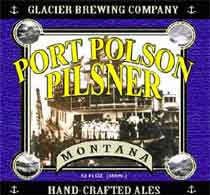Custom Northwest Montana Beer

Glacier Brewing Company in Polson, Northwest Montana
www.GlacierBrewing.com
www.GlacierBrewing.com
 Grinding Each brew requires a different recipe of pale and specialty malts. The mill gently crushes the malt to facilitate the conversion of the starch to sugar during mashing. The crushed specialty and pale malt, now called grist, is moved by auger to the mash tun. Here the grist mixed with water to form a mash in the mash tun.
Grinding Each brew requires a different recipe of pale and specialty malts. The mill gently crushes the malt to facilitate the conversion of the starch to sugar during mashing. The crushed specialty and pale malt, now called grist, is moved by auger to the mash tun. Here the grist mixed with water to form a mash in the mash tun. Mash In the mash tun, the mash sets for about 30 minutes, allowing the conversion of starches to sugar. After the conversion phase, vorlauf begins. During vorlauf, the "wort" is circulated in the mash tun to permit the mash to "set". During the next process, sparging, it is important that the sparge water flows through the mash at a proper rate to insure extraction of all the sugars.
Mash In the mash tun, the mash sets for about 30 minutes, allowing the conversion of starches to sugar. After the conversion phase, vorlauf begins. During vorlauf, the "wort" is circulated in the mash tun to permit the mash to "set". During the next process, sparging, it is important that the sparge water flows through the mash at a proper rate to insure extraction of all the sugars.Lauter and Sparge The malt sugar-rich liquid, now called wort (pronounced “wert”), is now moved by gravity from the mash tun to the brew kettle. In a process called lautering, hot water is used to sparge the mash to leach out the sugar extract. The volumes of water are carefully monitored to insure that the correct gravity (Plato) of the wort is achieved. Gravity relates to the amount of sugars in solution, and is important, since beer is ultimately produced by the conversion of sugar to alcohol and carbon dioxide.
 Boil As wort is added to the brew kettle, steam is used to bring the wort to boil. During the boil, which lasts between one-and-a-half to two hours depending on beer type, hops are added at different intervals to impart bitterness, flavor and aroma to the beer. At the end of the boil, the wort is passed through a heat exchanger which reduces the temperature from about 207 degrees F to 50-70 degrees F. In addition the wort is oxygenated while being pumped to a fermenter. The oxygen is required by the yeast for cell growth.
Boil As wort is added to the brew kettle, steam is used to bring the wort to boil. During the boil, which lasts between one-and-a-half to two hours depending on beer type, hops are added at different intervals to impart bitterness, flavor and aroma to the beer. At the end of the boil, the wort is passed through a heat exchanger which reduces the temperature from about 207 degrees F to 50-70 degrees F. In addition the wort is oxygenated while being pumped to a fermenter. The oxygen is required by the yeast for cell growth.  Pitching the Yeast Several days prior to brewing, the brewer propagates one of the different yeast strains we use in making our beers. The beer is transferred to the fermenter where fermentation occurs. Depending on the type of beer being produced fermentation takes place at temperatures ranging between 55-70 degrees for a period of 1 to 2 weeks.
Pitching the Yeast Several days prior to brewing, the brewer propagates one of the different yeast strains we use in making our beers. The beer is transferred to the fermenter where fermentation occurs. Depending on the type of beer being produced fermentation takes place at temperatures ranging between 55-70 degrees for a period of 1 to 2 weeks.Fermentation, Conditioning, and Packaging When fermentation is complete, the yeast slurry is collected and/or run off and the beer is moved to a conditioning tank. During conditioning, the beer is allowed to mature and additional yeast and proteins precipitate out of the solution. After conditioning, the beer is carbonated. From these tanks the beer is kegged. We sell our draft beer out of our Tap Room, and locally in select bars and restaurants in Polson, Missoula, and the Mission and Flathead Valleys.

6 Tenth Avenue East
Polson, Northwest Montana
Polson, Northwest Montana


